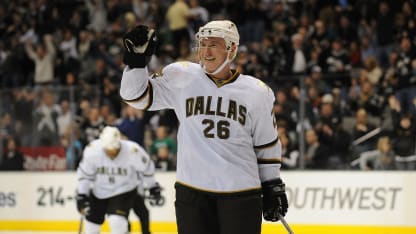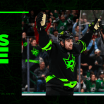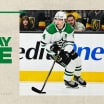Perhaps all you need to know about Jere Lehtinen, the moment that distills all of the accolades and the head-shaking commitment to playing hockey the right way, end to end, every night, was the day that head coach Ken Hitchcock tossed Lehtinen off the ice at practice.
Well, actually, Hitchcock tossed Lehtinen along with two Hall of Fame linemates Brett Hull and Mike Modano off the ice.
Lehtinen's lasting impact on Stars greater than words can describe
The three-time Selke trophy winner is set to be forever enshrined by the organization he gave his all to

"It was Hully I was mad at by the way," Hitchcock said when asked about the incident.
The longtime -- and once again -- head coach of the Dallas Stars insists that he was trying to give Lehtinen and Modano a rest.
Joe Nieuwendyk recalls that it didn't seem to bother either Hull or Modano that they'd been banished from the practice session.
"Modano and Hull couldn't get off the ice fast enough to head to the golf course," Nieuwendyk, another Hall of Famer, recalled. "And Jere really took it hard. Jere really took it hard. That's a cute little story that I remember about those guys."
Lehtinen grins when he's asked. Oh, yes, he recalls it.
"I remember that moment. Hitch said (to) our line, 'Get out, get out, get out, get off of the ice,' " Lehtinen said. "I kind of saw what happened. Hully was kind of doing -- sometimes he did his own thing, I thought he said him and maybe Mo (should go). And I tried to stay. I tried to hide."
Of course he did. But to no avail.
"Hitch said, 'Oh, no, all three of you. You've got to go. Go, you too, let's go. Get off.' I was (saying), 'What?' " Lehtinen said. "I tried to stay. Those two guys, I think they were already off, and I just tried to stay. But it didn't happen."
For such a nuanced game, we often take a simplified approach to defining greatness.
Most goals, assists, wins.
Fair enough.
But greatness doesn't exist in a vacuum. It's why when Paul Kariya and Teemu Selanne go into the Hall of Fame, as they did a few weeks ago, they make sure to mention longtime center Steve Rucchin, who, in some ways, allowed those great offensive talents to flourish through his own diligence.
Lehtinen, a three-time winner of the Frank J. Selke Trophy as the game's top two-way forward, was that and more, adding a unique -- some would say perfect -- counterweight to the Hall-of-Fame skill of Hull and Modano.
"He's like the perfect complement," Hull said in a recent interview. "He's probably in the top five most underrated or most unrecognized players to ever play in the NHL."
We're sitting in the stands at American Airlines Center with the understated Finn from Espoo. Periodically, people drop by to say hello.
In a few days, he will walk onto center ice with his family and watch as his No. 26 jersey will be raised to the rafters. Nervous?
He smiles and admits, yes, a few nerves. Public spectacle isn't really Lehtinen's thing.
But don't mistake the quiet demeanor for someone who is lacking self-confidence.
Even when he arrived in North America after the Minnesota North Stars selected him with the 88th overall pick in 1992, he seemed ready-made for the NHL.
He laughs at his first memories of Dallas after the franchise had moved from Minnesota in the summer of 1993 and he first came to North America.
"Actually, yesterday, we were driving past that hotel where we stayed in '95 -- in mid-July, actually. I'd just signed a contract couple of weeks before," he recalled.
An Omni somewhere near Interstates 635 and 35.
"In the middle of nowhere," Lehtinen said. "We came nighttime and in the morning and we look out and it was just flat here. That was first moment, basically. It's pretty hot. It was pretty flat. Same time that first day, we went to Valley Ranch to see the practice rink. Then you realize, okay, this is it."
He played junior and then in the Finnish elite league with TPS Turku. His teammates and longtime friends include Saku Koivu, whose father also helped coach them when they were younger. Kimmo Timonen and Miikka Kiprusoff also suited up with Lehtinen before all went on to distinguished NHL careers.
Koivu's younger brother, Mikko, idolized them all, but especially his brother and Lehtinen. They would come to the family cabin and fish and Mikko absorbed as much as he could.
"They were my heroes. And I was following them as much as I could," the Minnesota Wild captain said.
"They all were for me the older brothers."
Koivu's father and brother would often tell Mikko to watch Lehtinen -- how he prepared and played.
Later, Mikko would play alongside Lehtinen at Olympics in Turin and Vancouver, and last season would be a finalist for a Selke, carrying on the tradition of hard-working Finnish players for which Lehtinen helped create the gold standard.
"The work ethic, what he does, on the ice, the work he puts in for every game," Mikko said. "Then, when I had a chance to play with him, you realize how true it is and how much he actually works for the team."
Hitchcock was coaching Dallas's International Hockey League farm team in Kalamazoo, Michigan during the 1995-96 season when Lehtinen arrived. The idea was he would come and learn gradually to play the North American game, that the experience would groom him to play at the NHL level.
He played one game, was called up by Dallas and never returned.
He would play his entire NHL career, 875 games, with the Stars and another 108 in the postseason, including the team's seminal run to the Stanley Cup in 1999.
"When I came to coach him in pro, I found myself learning more from him than I could teach him. And so then, I just started focusing on why he does so well," said Hitchcock, who followed Lehtinen to the Stars during that same season, taking over with 43 games left in the season.
"I don't want to say the guy's the perfect player, but I found him to be the perfect team player. In other words, if you wanted things done right, then just watch him. And I found he's the only player since I've been in the NHL that I've never coached, like I never 'coached' him. I observed him, and I put him on the ice, and he played. But I never coached him. He coached himself. And he taught me more than I taught him."
We asked Nieuwendyk about watching Lehtinen evolve as an NHL player, and the three-time Stanley Cup winner laughed. Lehtinen didn't evolve, he just was.
"Well, he was kind of that player that he became right from the get-go," Nieuwendyk said. "I think a lot of players evolve, but I think he was kind of start to finish that type of player. Just very responsible. Sneaky offensive skills, but a really reliable 200-foot player. That's the way he broke in. That's the way he exited."
The last two years he was in Finland, Lehtinen played for Vladimir Yurzinov, a task master of wide renown. Yurzinov, like Hitchcock, created a demanding environment that kept players on their toes, which kept them from falling into the rut of becoming too comfortable.
"I can't say (Yurzinov) was tougher, but he was pretty much same (as Hitchcock)," Lehtinen said with a laugh.
Lehtinen had come from a winning background, but at a time when there were not a huge number of Finnish players in the NHL, coming to Dallas, well, "basically, you're coming to the New World."
To get better and play against the best meant, in some ways, starting over.
\[FULL SCHEDULE: Jere Lehtinen jersey retirement ceremony to begin with KIA Victory Green Carpet Walk at 5 p.m.\]
"But same time, when I came in the training camp -- I think I came week before, and I started to skate on the ice -- then you realize when you get on the ice, it's same game. It's a difference, smaller rink, and it's quicker. But at same time, it's hockey."
In keeping with his personality, Lehtinen downplays his role playing with Hull and Modano. Lehtinen insists he learned as much from those two high-profile, big personalities.
"We were kind of little bit different type of players," Lehtinen said, pausing to try and control a laugh.
Do you think?
"But all of our skills kind of put together made a pretty good line," he said.
He learned to use his skills and quickness from watching Modano, and Hull helped Lehtinen find spots on the ice to maximize his scoring potential.
"Same time, all of us learn from each other," he said.
Maybe Modano and Hull were destined to do what they did, regardless of who patrolled the other wing. Maybe not. He would never suggest it himself, but Lehtinen was the conscience of that line, perhaps the entire Dallas team that flirted for a time with the dynastic.
He was the "security blanket," Nieuwendyk said.
"I think he was the same way off the ice," Nieuwendyk said. "Very disciplined. Took his job really serious. He always did a lot of preparation on his own. I remember after practices, almost on a daily basis, he was religious about going to the blue line when the practice was over and working on his takeoffs. His two or three steps, and he had a really good quick takeoff speed. But he worked at it.
"Meanwhile, other guys were flipping pucks around or working on their shot, he was always doing that, so he was very religious about stuff that he felt that he needed to do to make sure he was prepared."
Hull recalled that between periods, guys would be relaxing or chatting with linemates or get half-undressed. Hull, for instance, would strip down and get a new dry shirt for the next period. "I would never undo my skates because I hated doing them back up," he said.
Lehtinen?
He would come into the room and set his helmet on the shelf above his stall. He would set his gloves next to the helmet and put his stick next to him, and he would sit there.
"And that was it," Hull said. "It was complete focus. It's so hard to put into words. He just sat there and looked forward. It was almost robotic."
Hull joked that he tried to tell Lehtinen it was okay if he didn't get killed by opposing defenders against the boards every time he went into the offensive zone, but Hitchcock said he's never encountered a player so skillful at winning 1-on-1 battles.
"Man, oh, man, I've never seen a guy play through people 1-on-1 and come up with the puck," Hitchcock said. "We'd always have a gauge on who won loose puck battles and he was at 98 percent every night. And that's almost unheard of now."
In Lehtinen's house in Finland, there's a glass case in which he keeps his Stanley Cup ring and other hockey mementos. In that case are four Olympic medals as well -- one silver and three bronze.
And it's one of the reasons that Hull feels that there should be more attention paid by the Hockey Hall of Fame to players like Lehtinen, or another great Stars defensive specialist, Guy Carbonneau.
"It's incredible. I'd like to get a movement going where some of these guys get some recognition for the Hall of Fame," Hull said. "It's unfair that it's always just the numbers that get you in."
Lehtinen is, in some ways, the prototypical Finn: low-profile, industrious, hard-working.
It's what we have come to expect from Finnish teams at best-on-best tournaments.
Timonen knows the full Lehtinen experience, having played with him in the mid-1990s in Finland, and then multiple times internationally, while having to try and contain him as an NHL defenseman.
"On the ice, he was one of the toughest players to play against," Timonen said. "There wasn't a time when he was going to give up."
At events like the Olympics, "That's the way we had to play in order to be successful," Timonen said. "He made a huge impact for many players and made them better."
Current Dallas netminder Kari Lehtonen played with Lehtinen at the 2004 World Cup of Hockey in where the Finns lost to Canada in the final. He also played with Lehtinen near the end of his career in Dallas.
"It was an honor. He's one of the legends, especially my age of Finnish kids that were growing up, and he came here," Lehtonen said. "Just his demeanor and work ethic -- the way he treated this game. Just perfect player. So, it was neat to see up close."
He, like other Finnish players, believe that Lehtinen's profile -- even in Finland -- isn't as great as it should be.
"The hockey people know and appreciate the way he played -- what he did," Lehtonen said. "But certainly, he wasn't the flashy guy on the news all the time doing all this stuff that doesn't help him as a hockey player. Probably that's why he's not in every car commercial in Finland nowadays."
He may not be on car commercials, but Lehtinen remains very much a fixture in Finnish hockey.
He helped scout NHL players in advance of the 2014 Olympics in Russia for Hall of Fame general manager Jari Kurri. And then he took over as GM of the World Cup of Hockey team last fall and is building the Finnish Olympic team that will compete in South Korea early in 2018.
He falls back on the moments he spent with people like Bob Gainey and Les Jackson and Doug Armstrong, and former Dallas coaches Hitchcock and Dave Tippett.
"When I retired, I took half-year kind of little bit off everything -- hockey and everything," Lehtinen said. "But it was pretty quick I realized, you know, that's what I live for. And I want to stick with the hockey, and of course over those years with Gainey and Hitch, and Tip and Armstrong, and those guys, you learn a lot.
"Even that time you didn't even think about that, because you just wanted to play. Now, it's easier to look back and see how they did things. And now, what I'm doing now with the national team, and in the future, I don't know what's going to happen, but you learn a lot from those guys."
And who knows?
The NHL has pretty much been a closed shop to European executives over the years with fellow Finn Jarmo Kekalainen, the GM of the Columbus Blue Jackets being a notable example. So, perhaps, a door will open for Lehtinen on that side of the hockey business down the road.
In the meantime, he is trying not to think too much about the speech he will give after he sees his number rise to the rafters in Dallas. And he thinks, at least for a moment, about the unpredictability of it all.
"I'm so fortunate everything I was able to do," the father of three, including 17-year-old twin daughters and a 14-year-old son, all born in the U.S., said.
"I never thought I could play in the NHL as a kid and even in junior. And then it happened."
The Stanley Cup. The Selke trophies. The Olympic successes. And now, a jersey with his name that will forever remind fans of his own contributions to a franchise and a game.
"It's the most what you can get from an organization," he said. "It's humbling, really. It's speechless kind of thing."
As it should be for a man noted mostly for his actions on the ice and not the words he spoke.
This story was not subject to approval of the National Hockey League or Dallas Stars Hockey Club. You can follow Scott on Twitter @OvertimeScottB, and listen to his Burnside Chats podcast here.


















